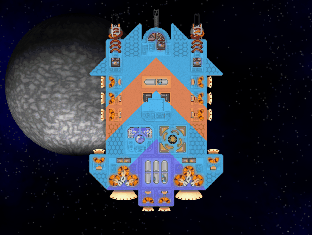

Their paint is typically left over from however the original ships were painted, albeit more scuffed and faded, and often with additional markings (clan symbols, kill counters, etc.) applied. As such, Fringe ships are generally considered to be poorly "designed" (if that word can even be applied), with little rhyme or reason, often appearing misshapen or even "organic". The ships of the Fringe are typically ships from the other factions that have been salvaged, repaired, and repurposed, pieced together from multiple such ships, or constructed and expanded over time on an ad-hoc, as-needed basis. Despite this cooperation, the Fringe systems are no match for the full might of any of the major factions, and thus are fighting a doomed battle, losing their independence one-by-one. There are no formal cooperation agreements between any of the Fringe systems, so the extent to which they can be called "unified" is based on a mutual hatred of the other major factions and an understanding that they can better defend their independence working (begrudgingly) together than apart. As such, the Fringe systems tend to attract a "rough and ready" type of personality, and piracy runs rampant. While there is a strong code of honor among inhabitants of the Fringe, there is no common government or system of laws beyond the borders that can be enforced by each individual settlement or station.

They are generally sparsely populated and have a low standard of living. The "Fringe" star systems are those that lie on the edge of the known galaxy or between the territories of the major factions. While Railguns are the major new feature in 0.14.1, there are also a ton of more minor improvements, bug fixes, and modding features, all of which you can read about in the changelog.The Fringe Systems Resistance is a loose conglomeration of independent star systems united only by the common desire to survive and remain independent. Additionally, if any single piece of a Railgun is destroyed, then the whole thing chain-reacts and explodes, possibly causing collateral damage around the Loader if it is containing any shells at the time.

Crew must deliver power to every Accelerator segment individually, and if a single Accelerator is out of power, then the entire Railgun can't shoot, meaning longer Railguns can have a lower rate of fire unless their crew are highly efficient at powering every Accelerator. For every Accelerator that is added, the Railgun requires that much more power to shoot. Long enough Railguns can even penetrate through enemy shields!īut very long Railguns aren't without their downsides. Every additional Accelerator that is added increases the fired slug's speed, damage, and penetration depth.Īs can be seen in the above screenshot, extremely long Railguns (such as the one on the newly-redesigned Archangel) can reach incredible damage and penetration, often shooting all the way through enemy ships, wreaking havoc in their path. Every Railgun has both a "Loader" (where the cannon shells are loaded and where the crew operate the controls) as well as a "Launcher" (where the slug exits the Railgun at high speed), and they can also have any number of optional "Accelerators" placed in between the Loader and Launcher.

And, like the Ion Beam Emitter, the Railgun is a fixed-direction weapon that cannot aim independently of its ship.īut perhaps what makes the Railgun the most interesting is that it is actually constructed using three different kinds of parts and can be built in various different lengths. Because the railgun uses magnets to accelerate the slugs, it requires both cannon shells and power to fire. These slugs can reach extremely high velocity, allowing them to inflict great damage and penetrate deep into enemy ships, often destroying vital enemy systems in the process. The Railgun is a projectile weapon that uses magnets to accelerate an explosive slug down a pair of long magnetic rails.


 0 kommentar(er)
0 kommentar(er)
